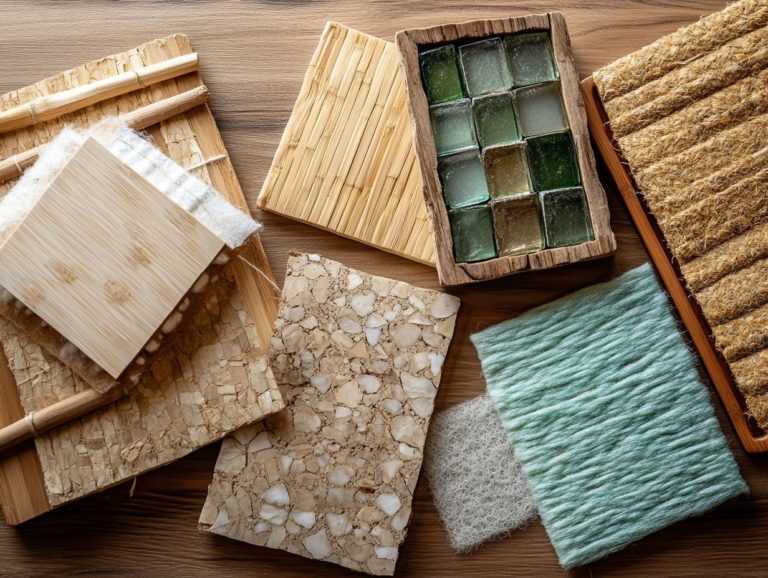Exploring the Versatility of Natural Materials
In an era that prioritizes sustainability and health, natural materials are stepping into the spotlight.
From eco-friendly construction to stylish fashion, these materials enhance your life and show kindness to the planet. This article explores the benefits of using natural materials and their positive impact on the environment and your health.
You’ll discover various types of organic and renewable materials and their applications across different industries. Whether you’re a homeowner or a designer, this exploration of natural materials will inspire you.
Contents
- Key Takeaways:
- Benefits of Using Natural Materials
- Health Benefits
- Types of Natural Materials
- Applications of Natural Materials
- Challenges and Limitations of Natural Materials
- Frequently Asked Questions
- What is meant by exploring the versatility of natural materials?
- Why is it important to explore the versatility of natural materials?
- What are some examples of natural materials that are versatile?
- How can we explore the versatility of natural materials in our daily lives?
- What are the benefits of using natural materials instead of synthetic ones?
- Are there any limitations to using natural materials?
Key Takeaways:

- Natural materials are eco-friendly and offer health benefits, making them a better choice than synthetic alternatives.
- Organic and renewable materials are widely used for their versatility and sustainability.
- From construction to fashion, natural materials are a versatile choice for many industries.
Defining Natural Materials
Natural materials encompass a variety of substances sourced directly from the Earth. This includes natural fibers like cotton and bamboo, as well as biodegradable materials and renewable resources.
These elements play a crucial role in fostering eco-friendly practices across industries, from home d cor to fashion. By choosing these materials, you reduce the amount of harmful gases you produce and improve indoor air quality.
As demand for sustainable products rises, the significance of organic cotton grown without harmful pesticides becomes clearer. This highlights the importance of environmentally responsible textiles.
Sourced from renewable resources, these materials provide aesthetic appeal while serving vital roles in sectors such as architecture, packaging, and automotive manufacturing. Their ability to break down naturally helps minimize landfill waste and promotes a circular economy.
This shift towards natural materials represents a larger trend of sustainable living, urging industries to rethink their practices for the benefit of consumers and the planet.
Benefits of Using Natural Materials
By incorporating natural materials into your daily life, you unlock a multitude of benefits. You can enjoy improved indoor air quality, experience enhanced health advantages, and support sustainable practices.
Make this choice today and enjoy the benefits of timeless aesthetics that these versatile materials offer.
Environmental Impact
The environmental impact of utilizing natural materials is significant. These choices greatly reduce your carbon footprint and promote sustainability.
Choosing materials like bamboo, cork, and organic cotton helps lower pollution levels. Research shows bamboo can sequester carbon up to 30% more effectively than comparable hardwoods. Switching from synthetic fibers to organic cotton can cut water consumption by up to 91% while reducing harmful chemicals that contaminate waterways.
By adopting eco-friendly practices such as composting and recycling natural materials, you can decrease landfill waste and improve soil health. This multifaceted approach to environmental conservation benefits not only ecosystems but also the local communities that thrive within them.
Health Benefits
Natural materials can supercharge your health and boost indoor air quality! They are typically non-toxic and free from harmful chemicals that synthetic alternatives often contain.
When you choose organic materials for your home decor and personal care products, you reduce your exposure to allergens and toxins. This thoughtful choice can lead to a healthier living space and enhanced overall well-being.
Many synthetic items release chemicals that can harm breathing and worsen allergies. By opting for natural cleaning solutions and furnishings made from renewable resources, you can further minimize the risk of chemical sensitivities and create a serene atmosphere.
This, in turn, boosts both your physical health and emotional comfort.
Types of Natural Materials

Natural materials can be divided into three categories: organic materials, renewable resources, and natural fibers. Each category presents unique advantages and influences various industries, from the robust structures of construction to the refined aesthetics of fashion and home decor.
Organic Materials
Organic materials like organic cotton and bamboo are grown without harmful chemicals, providing you with eco-friendly choices that support sustainability and promote healthier living.
These materials not only help you reduce the carbon footprint linked to their production but also encourage sustainable farming practices that enhance soil health and biodiversity.
In fashion, opting for organic fibers means you can enjoy stylish garments that are gentle on your skin and free from toxic chemicals. This is perfect for the environmentally conscious consumer.
In home decor, choosing organic linens and furnishings brings a natural aesthetic into your space, contributing to a harmonious living environment. In personal care products, organic ingredients ensure that what you put on your skin is safe and non-toxic, aligning with a holistic approach to wellness and sustainability.
Renewable Materials
Renewable materials, such as natural fibers and sustainably sourced timber, are essential for sustainable design. They provide versatile options for eco-conscious consumers in industries like construction and home decor.
These materials come from sources that regenerate over time, including bamboo, cork, and reclaimed wood. This reduces waste and minimizes the carbon footprint associated with extraction and processing.
When you incorporate renewable materials into your building structures and interior decor, you’re adopting an eco-friendly ethos while meeting the growing demand for sustainable living solutions.
You can see this commitment in furnishings made from recycled plastics or biodegradable fabrics, which beautifully blend modern aesthetics with nature’s principles.
As the trend toward sustainability continues to gain traction, the importance of these materials in enhancing durability and lessening environmental impact becomes increasingly clear.
Applications of Natural Materials
Natural materials offer a wealth of possibilities across a range of industries, from construction to fashion and home decor. Their versatility elevates not only aesthetic appeal but also champions environmental sustainability.
Choosing these materials now means you’re investing in a healthier future for you and your family.
Construction and Building
In the construction industry, natural materials like stone and sustainably sourced timber are highly regarded for their durability, aesthetic appeal, and commitment to environmental sustainability.
These materials elevate the visual allure of your structures and offer impressive strength and longevity, making them the go-to choice for builders and architects alike. For instance, natural stone has unique textures and color variations that provide excellent ability to store heat, helping to regulate indoor temperatures and reduce energy costs.
Similarly, sustainably sourced timber delivers superior insulation, enhancing energy efficiency while reducing the carbon footprint of your building projects. By embracing these materials, you contribute to a shift toward eco-friendly practices in the industry, ultimately fostering healthier living environments.
Fashion and Textiles

The fashion industry increasingly embraces natural fabrics like organic cotton and bamboo. These options showcase a commitment to ethical fashion while offering unparalleled comfort and breatheability.
By prioritizing these sustainable materials, designers respond to your growing demand for transparency and responsibility in sourcing and production practices. As a savvy shopper, you are becoming more aware of the environmental and social implications of your clothing choices, driving the shift toward brands that utilize materials such as hemp and linen.
These natural textiles are often biodegradable and less harmful to the planet, perfectly aligning with your values in sustainable fashion. As more companies adopt these practices, they contribute to a circular economy that emphasizes longevity and minimizes waste, reinforcing the notion that fashion can be both stylish and environmentally responsible.
Home and Lifestyle Products
Products crafted from natural materials are not just visually appealing; they foster a healthier living environment when complemented by eco-friendly cleaning solutions and sustainable design principles.
Recently, you ve likely noticed a significant shift toward embracing eco-friendly options in everyday life. Choosing products made from organic cotton, bamboo, and reclaimed wood not only lessens your environmental footprint but also improves the air quality in your home.
As you become more attuned to the long-term benefits of selecting natural materials, you ll find that this approach aligns beautifully with sustainable living practices and enhances your mental and physical well-being.
By opting for items that prioritize natural ingredients, you can cultivate a serene sanctuary that nurtures both body and mind, ultimately supporting a lifestyle that resonates harmoniously with nature.
Challenges and Limitations of Natural Materials
Despite their numerous advantages, natural materials present certain challenges and limitations. You may encounter issues related to availability and cost, along with the necessity for proper maintenance to ensure their longevity and optimal performance.
Availability and Cost
The availability and cost of natural materials can vary significantly, influenced by factors like sourcing locations and the sustainable practices employed in their production. These variations can profoundly impact your choices as a consumer.
Fluctuations in these areas affect pricing structures across different industries and shape broader market trends as companies navigate the intricate landscape of renewable resources. Logistical challenges, including transportation costs and supply chain disruptions, further complicate efforts to maintain a consistent supply of these materials.
In a world increasingly focused on sustainability, it’s crucial for businesses to consider how their sourcing practices resonate with eco-conscious consumers. Striking a balance between cost-effectiveness and environmental responsibility is essential. Ultimately, the interplay of these factors underscores the importance of adopting innovative sourcing strategies to ensure long-term viability.
Choosing natural materials comes with both rewards and challenges. Awareness and understanding can lead to better choices that support sustainability.
Explore more about natural materials and consider making eco-friendly choices in your everyday life!
Durability and Maintenance
The durability and maintenance of natural materials are crucial factors to consider. Some materials require more care than synthetic alternatives.
Take, for example, items crafted from wood, stone, or organic textiles. These often require specific cleaning methods that are safe for the environment. Using natural cleaners helps preserve their quality.
Regular dusting and promptly addressing spills can profoundly enhance the lifespan of these materials.
By utilizing non-toxic cleaners, such as vinegar or baking soda, you can effectively minimize wear while being kind to the environment. Recognizing the importance of proper care helps maintain aesthetic appeal and supports sustainability.
Using natural materials promotes sustainability and reduces our reliance on synthetic options. Are you ready to make the switch to natural materials for a healthier living space?
Frequently Asked Questions

What is meant by exploring the versatility of natural materials?
Exploring natural materials means finding out how we can use them in different ways.
Why is it important to explore the versatility of natural materials?
It allows us to utilize these resources sustainably, reducing our dependence on synthetic materials.
What are some examples of natural materials that are versatile?
Examples include wood, bamboo, cork, clay, and wool. These materials can be used for construction, clothing, furniture, and more.
How can we explore the versatility of natural materials in our daily lives?
We can choose to purchase products made from sustainable materials, like bamboo utensils or recycled paper.
What are the benefits of using natural materials instead of synthetic ones?
Benefits include reducing our carbon footprint, supporting sustainable practices, and promoting healthier environments. Natural materials are also biodegradable and easily recycled.
Are there any limitations to using natural materials?
While beneficial, natural materials may need more maintenance and can be harder to find.






